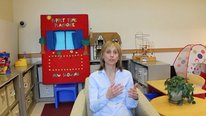- Katie Stokinger
- Zoombinis Research
- http://edgeatterc.com
- TERC
- Jodi Asbell-Clarke
- http://edgeatterc.com/edge/
- Director, EdGE at TERC
- Zoombinis Research
- http://edgeatterc.com
- EdGE at TERC
- Teon Edwards
- Co-founder of EdGE, Game Designer, and Production Manager
- Zoombinis Research
- http://edgeatterc.com
- EdGE at TERC
Public Discussion
Continue the discussion of this presentation on the Multiplex. Go to Multiplex









Wendy Martin
This game is very clever. I am very interested in your bridging condition. It sounds similar to what my team at EDC is studying in our project Digital Games as Analogical Sources for Science Learning (check out our video!) It’s crucial to investigate how teachers follow up on educational games during classroom instruction, to understand how to translate what students begin to understand through playful experience to a new context. What do teachers do in your bridging condition? Do you have specific techniques or materials they use, or do you ask the teachers to make their own connections to their curriculum?
Katie Stokinger
Great question! We are planning on providing Bridge condition teachers with a set of suggested classroom activities that will help them bridge specific puzzles to explicit CT concepts, but teachers will be free to experiment and modify those materials as they see fit for their classrooms. We will collect reflection logs from teachers to learn more about their classroom practices throughout the study and will put together case studies of Bridge classrooms as part of our findings.
Lisa Samford
Executive Director
Hi Katie—I’m also interested in the bridge condition and games classes—as I understand it, in both groups students played the games outside the classroom environment. Did schools provide the computers for home use or was there some kind of analysis that incorporated “access” into the mix?
Katie Stokinger
Hi Lisa! Thanks for the question. Student access to computers and/or tablets outside of school hours is part of our screening process when selecting classes to participate in research studies. Because this access is vital to our study, we only accepted teachers into the study if they reported in their applications that a majority of their students have access to these technologies after school hours, either in a school or public computer lab or in their homes (owned or borrowed through a school program). We ranked the quality of their technology access based on the information teachers provided and created the Control, Game Only, and Bridge groups so they had, as a whole, have comparable levels of technology access. For the upcoming Zoombinis study, we will also be asking teachers about classroom access to technologies as some Bridge activities rely on gameplay. As we have done with out-of-school access, we seek to create comparable groups in terms of the in-class technology access.
Vivian Guilfoy
Senior Advisor
Demystifying concepts like Computational Thinking and conditional reasoning through Zoombinis offers learners a great entry point into this learning space. Like the others who have posted here, I am very interested in how the bridging function operates and contributes to learning. Could you say more about how you are measuring what students learn? Also, does your research on the bridging group extend to informal learning environments as well as classrooms?
Katie Stokinger
We are working with Val Shute and Matthew Venture of Empirical Games to develop assessments of computational thinking. We are still in the development and testing phase. The items are a set of logic puzzles whose solution is made easier with computational thinking skills in the same way Zoombinis is.
Our current grant and prior work focuses on in-school learning with games, but we too see many applications of this work in informal settings.
Tamara Ball
Asst. Project Scientist
Have you been able to tease out an reliable differences between the way learners interact with your game across in-school and out-of-school settings? Amidst all the research in the learning sciences that talks about the social context of learning this seems like it could be a neat way to use the same treatment across settings and see what plays out.
Katie Stokinger
Tamara, we’re only at the very beginning stages of our research, and looking across in-school and out-of-school isn’t part of our current plans, but you ask an interesting question. It could be interesting to see if differences between in-school and out-of-school play of the game occur.
Tamara Ball
Asst. Project Scientist
If you do decide to go the in-school comparisons with out -of school route get in touch with me! I would be interested to follow or even collaborate on your work.
Tamara Ball
Asst. Project Scientist
I am impressed by the quality of the content of this puzzle game and what it compels the learner to pay attention to and think through. There are so many games coming through right now it can be easy to get lost in the sea of possibilities. I wonder if you can say more about if and how the players are becoming aware (meta cognition) of “Logic and conditional reasoning” they are using to get the characters across the bridges in the game. There might also be something about your “bridge condition” (game to classroom treatment) that ties into the concept of metacognition . I could imagine that reapplying what they did in one context to what they are being asked to do in a second context could provoke greater (meta) reflection on what they accomplished previously and how.
Katie Stokinger
Tamara, again, we’re only at the very beginning stages of our research, so unfortunately, we don’t have enough data to be answering questions like this yet. Completely anecdotally, we can see shifts in players’ behavior when they move from from randomly trying things, to testing a hypothesis, to implementing a solution; for some players, repeated experience with this probably does involve building an awareness that’s beyond the specifics of a particular puzzle. This is part of what we hope to explore. In addition, experience with research on our other games suggests that gameplay alone can help build tacit understanding of concepts, but that the role of the teacher is vital to players making the connection between those tacit understandings and explicit school content. As you say, the “bridge condition” is a place where teachers may involve their students in connecting what a player is doing in a puzzle to a general CT skill, reflecting on the process of finding a solution, and transferring what they are doing to other contexts.
Tamara Ball
Asst. Project Scientist
It seems like you have a lot of good ideas about how to focus your research agenda going forward.
I would be especially interested to hear how you would pinpoint and distinguish or identify instances when a player is “testing a hypothesis” vs. “randomly trying things”
Vivian Guilfoy
Senior Advisor
Are you seeing differences across grades 3-8 in the ways that student approach the game, “play” with it, develop skills in problem solving, etc. What are they? Any gender differences?
Katie Stokinger
Vivian, great questions. Unfortunately, we’re too early in our research to answer any of them.
Helen Teague
You have produced a video that is able to explain, illustrate, and summarize your extensive study- all in 3 minutes! Encouraging to see an emphasis on logic and diverse learner population… the concept of the “bridge” also vaults the experience for students beyond just a “gee-whiz-neato gadget-based experience” to deeper learning. I’m looking forward to follow your research as it progresses! Thank you!!
Katie Stokinger
Thank you for the comment Helen!
Barbara Ericson
Nice video that shows the type of logical reasoning the students have to engage in to solve the puzzles. What type of data are you currently gathering (pre/post attitude surveys, log file data, video, etc)?
Jodi Asbell-Clarke
Director, EdGE at TERC
Hi – we are gathering all of the data forms you mention. We use video observations to build our initial “groundtruthing” about what types of strategies and moves players are using that are consistent with our model of CT learning. That helps us ensure we are building complete data distillers that will capture and calculate the parameters we need for our data mining models.
We also use pre-post tests (in development and validation with partner Val Shute of Empirical Games) to measure the impact of the game under the various study conditions (control,game, and bridge)
In addition we collect teacher reports of what happens in class, and we are conducting observations and interviews in a few sample classes.
thanks for you interest!
Vivian Guilfoy
Senior Advisor
Great program with rich possibilities for understanding the development of learning across groups and ages. Look forward to following this work.
Jim Sandherr
Thanks for sharing this video! I’m curious about the teachers’ own experience with games, both in their personal lives, and as part of their teaching methods. How does an educator’s “game literacy” come into play when helping them introduce a game like this into their classroom practice?
Jodi Asbell-Clarke
Director, EdGE at TERC
Interesting question. In our past studies we have found that teachers seemed less comfortable with the gameplay than their students. But in this case, Zoombinis is a game that some of these teachers played themselves as a child or remember for when they were teachers in the 1990’s. It will be interesting to see if that nostalgia factor plays into more effective education.
Sophie Joerg
Beautiful project and game! I would be interested in knowing more about how the game was made. What engine did you use? Were students involved in the design and implementation?
Jodi Asbell-Clarke
Director, EdGE at TERC
Hi Sophie – Zoombinis was developed by TERC in the 1990s and was published by Broderbund (and their successors). It then went dormant as the publishers did not update for newer computers. In 2015, TERC partnered with FableVision and the Learning Games Network to re-release Zoombinis on today’s platforms. It was developed in Unity.
Ugochi Acholonu
Great project! It seems like there is a lot of data that you are capturing. Are you exploring any learning analytics with the data?
Jodi Asbell-Clarke
Director, EdGE at TERC
absolutely. We are currently building the distillers (based on observations) for the data logs and data mining models and research are one of the primary outcomes of the project.
Further posting is closed as the showcase has ended.